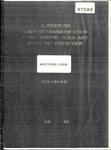A STUDY ON WIRELESS COMMUNICATION ERROR PERFORMANCE AND PATH LOSS PREDICTION
| dc.contributor.supervisor | Tomlinson, Martin | |
| dc.contributor.author | Isnin, Ismail | |
| dc.contributor.other | School of Engineering, Computing and Mathematics | en_US |
| dc.date.accessioned | 2011-04-19T10:14:58Z | |
| dc.date.available | 2011-04-19T10:14:58Z | |
| dc.date.issued | 2011 | |
| dc.identifier | 241138 | en_US |
| dc.identifier.uri | http://hdl.handle.net/10026.1/324 | |
| dc.description.abstract |
One channel model that characterises multipath fading effect of a wireless channel is called Flat Rayleigh Fading channel model. Given the properties of Flat Rayleigh Fading channel, an equation to find the capacity of a Flat Rayleigh fading channel with hard decision decoding is derived. The difference of power requirement to achieve the Additive White Gaussian Noise (AWGN) capacity over a Flat Rayleigh Fading channel fading is found to increase exponentially with Es /N0 . Upper and lower bounds of error performance of linear block codes over a Flat Rayleigh Fading channel are also studied. With the condition that the excess delay of a channel is known earlier, it is shown that a correlator with shorter length, according to excess delay of the channel, can be constructed for use in wireless channel response measurements. Therefore, a rule of construction of a shorter length correlator is defined, involving concatenation of parts of a Constant Amplitude Zero Auto-Correlation (CAZAC) sequence. Simulation of [136,68,24] Double Circulant Code with Dorsch List Decoding is also done in order to evaluate error performance of the channel coding scheme over one of the IEEE Wireless Metropolitan Area Network (WirelessMAN) channel models, the Stanford University Interim Channel Model No. 5 (SUI-5) channel. Performance of the channel cod- ing was severely degraded over the SUI-5 channel when it is compared to its performance over the AWGN channel. Indoor path losses within three multifloor office buildings were investigated at 433 MHz, 869 MHz and 1249 MHz. The work involved series of extensive received signal strength measurements within the buildings for all of the considered frequencies. Results have shown that indoor path loss is higher within a square footprint building than indoor path loss in a rectangular building. Parameters of Log-Distance Path Loss and Floor Attenuation Factor Path Loss models have been derived from the measurement data. In addition, a new indoor path loss prediction model was derived to cater for path loss pre- diction within multifloor buildings with indoor atriums. The model performs with better prediction accuracy when compared with Log-Distance Path Loss and Floor Attenuation Factor Path Loss models. | en_US |
| dc.description.sponsorship | Ministry of Higher Education of Malaysia, Universiti Teknologi Malaysia | en_US |
| dc.language.iso | en | en_US |
| dc.publisher | University of Plymouth | en_US |
| dc.subject | Indoor Path Loss Prediction | en_US |
| dc.subject | Dorsch List Decoding | en_US |
| dc.subject | 433 MHz | en_US |
| dc.subject | 869 MHz | en_US |
| dc.subject | 1249 MHz | en_US |
| dc.title | A STUDY ON WIRELESS COMMUNICATION ERROR PERFORMANCE AND PATH LOSS PREDICTION | en_US |
| dc.type | Thesis | |
| dc.identifier.doi | http://dx.doi.org/10.24382/4331 |
Files in this item
This item appears in the following Collection(s)
-
01 Research Theses Main Collection
Research Theses Main


